50 ERP Statistics
Modern companies use ERP software for the tools they need to automate important business processes. Here are 40+ ERP statistics you need to know to fully understand the potential benefits, costs, and drawbacks, based on both internal Software Connect data and top surveys of ERP buyers across the Internet:
General ERP Statistics
- Top benefits of ERP, as named by prospective buyers, are: increased collaboration, centralized data, and reduced process time [1]
- Top business goals businesses site when seeking ERP: cost savings (46%), better performance metrics (46%), and more efficient transactions (40%) [2]
- Top motivations buyers cite when seeking new software include the need for better features (26.5%), a desire to automate existing processes (15.9%), and a brand new system for a new business (14.6%) [3]
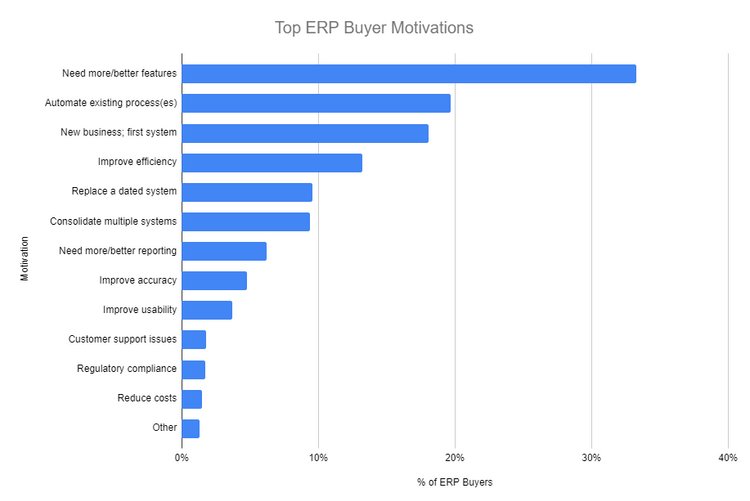
Features, Add-ons, and Customization
- Accounting is the main feature wanted in an ERP, per 89% of buyers [4]
- Respondents cited the need for modules with inventory and distribution (67%), customer relationship management (CRM) (33%), and general technology (21%) [4]
- Only 3% of companies are using ERP with out-of-the-box functionality - the rest use some degree of customizations [5]
- 33%-48% of businesses request moderate customization and 10%-19% only request “personalized” ERP solutions [5]
Deployment Options
- 64% of companies seek SaaS ERP while 21% want entirely cloud-based options and 15% want on-premise solutions [6]
- The perceived risk of both data loss and security breaches, or a lack of information other deployment options are the main reasons companies avoid cloud-based solutions [7]
- Cloud-based ERP interest went from 4% in 2013 to 42% in 2022 [3]
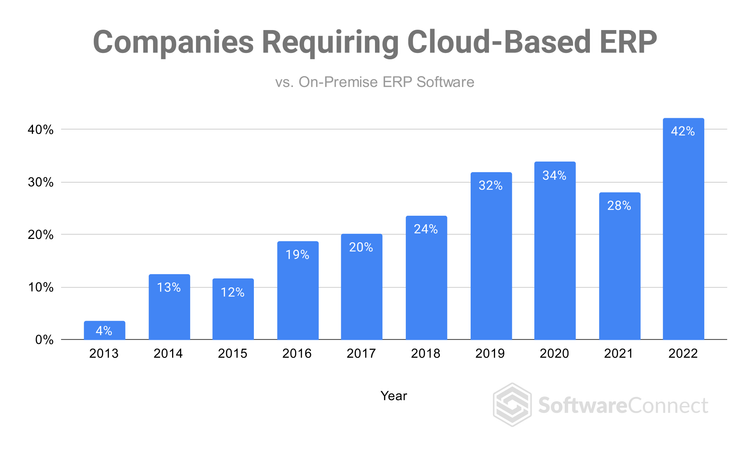
ERP Tech Trends
ERP trends can change drastically from year to year, but here are some of the top predictions:
- AI, machine learning, IoT, and cloud-based ERP are all increasing in popularity
- Artificial intelligence (AI) is advancing ERP capabilities with greater automation and faster results, with 65% of CIOs predict AI integration into ERP by 2022 [8]
- iERP (Intelligent ERP) is expect to grow in coming years [9]
- Some companies are utilizing two-tiered ERP systems to better balance more specific work, such as implementing a new ERP for financials while maintaining a familiar legacy system for HR purposes [3]
Global ERP Software Market Share
- The global ERP market share of 2022 was valued at $50.57 billion in 2021 [3]
- And according to the current growth rate, the global ERP market could reach $123.4 billion by 2030 [5]
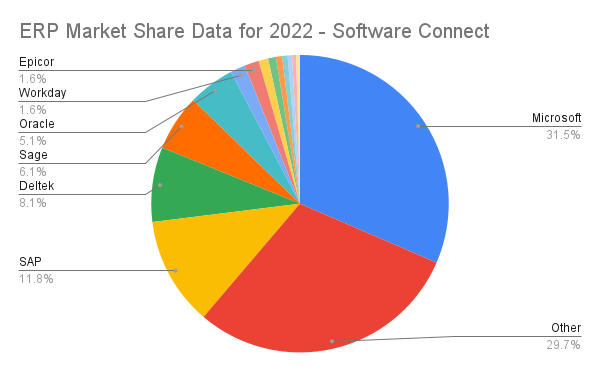
Main Industries Adopting ERP
- Manufacturers in general are the top industry for purchasing ERP (47%), followed by distributors (18%), services (12%), and construction (4%) [4]
- The most industry demand is in Defense and Aerospace, Retail, and Government Organizations [10]
- Of these, the defense and aerospace industry has highest adoption rate of ERP (G2)[11]
- The global ERP market size for healthcare was estimated at $6.2 billion in 2020 and was expected to reach $6.6 billion by 2021 [12]
Market Statistics by Geographic Region
- Asia-Pacific is fastest-growing market with expected growth of 9.8% by 2027 (TrueList) [13]
- India, China, Japan, and Singapore are seeing most growth over next 5 years, followed by Latin America nations such as Brazil [10]
- The Enterprise Resource Planning Market in the US is expected to exceed more than $49.50 billion by 2027 [14]
ERP Usage Statistics
- According to respondents, only about 26-27% of workers use ERP [15][13]
- ERP users are primarily top decision-makers, though different departments can have more users than others [3]
- Company owners and C-suite executives (50.8%) are the most likely to begin the software buying process [3]
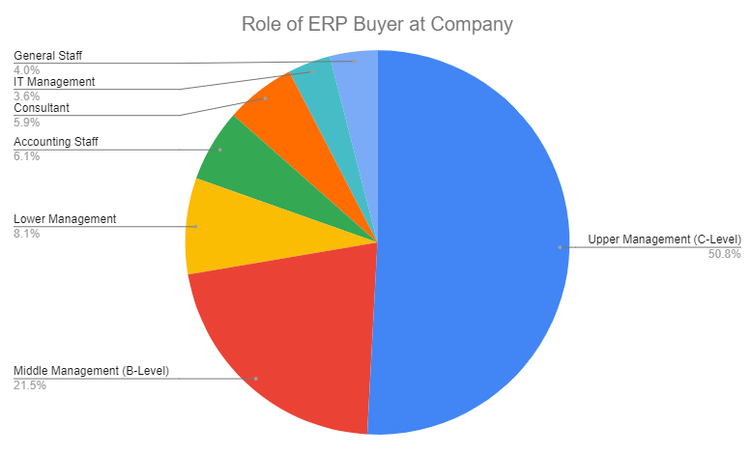
ERP Statistics about Implementation
Implementation is the process of rolling out an ERP at a business. These statistics look at how long it takes and how much it costs.
Implementation Timeline
- Selecting ERP can take around 17 weeks to complete [16]
- 85% of companies want their implementation complete within one year and 30% want implementation within 6 months [5]
- 49% of companies implemented on-time [17]
- Yet ERP implementation still took 30% longer than predicted for many companies [18]
ERP Costs and Budgeting
- The total cost of ownership of an ERP system depends on a wide variety of factors, but can quickly reach hundreds of thousands or millions [3]
- 84% of users only anticipated spending 2% of annual income on ERP [6]
- TCO for large companies ($1+ billion in revenue) is 2-3% of annual revenue [19]
- 45% of ERP implementations go over budget [4]
- Main reason companies go over budget during implementation because of expansion of initial project scope [17]
- Subscription ERP plans can be cheaper upfront, but within 8 years the cost is equal to a one-time perpetual license model [3]
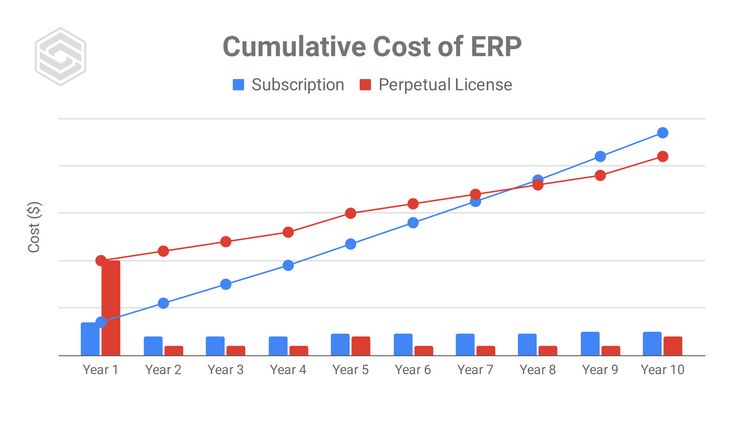
Failure Rates
- Biggest implementation challenges, as reported by buyers, are insufficient testing and not enough process reengineering [20]
- Half of ERP implementations fail [18]
- The implementation failure rate is between 55% and 75% for first time buyers [21]
- Implementation failure is most common on the first try [22]
- 82% of employees resist new ERP software, increasing failure rates [23]
- Only 8% of businesses had issues with technical changes of ERP implementation; however, 75% claimed organizational change was the bigger challenge [6]
ERP implementation failure happens, often due to complications with integrating legacy systems or training users. However, the risks of using ERP are often outweighed by the benefits:
Success Stories
- The average return on investment after implementation of an ERP is 2.5 years [17]
- 88% of organizations believed their new ERP helped their business overall (SelectHub) [4]
- 95% of businesses saw process improvement after implementation [24]
- Successful ERP implementation case studies all shared clear goals set before the process began [4]
- 65% of small businesses are using ERP consultation services to streamline the implementation and prevent failure [25]
Important ERP Statistics Before Buying
When a company has decided on upgrading ERP or adding a new system, there are a few key things to consider:
Best ERP Products
- NetSuite, Odoo, Sage Intacct, SYSPRO, Oracle ERP are among the top performing software solutions on the market [26]
- Out of these service providers, Microsoft Dynamics forms 29% of the ERP market [5]
- 6.7% of buyers request demos or pricing information on Sage Intacct, followed by SAP Business One at 5.5% and NetSuite ERP at 5% [3]
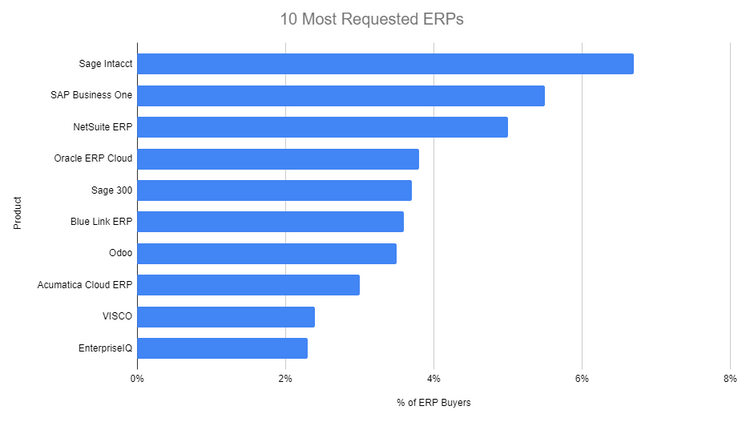
Learn more about some of these top ERP products:
Along with these popular ERP solutions, there are some important starter options:
- Popular starter option is QuickBooks, an accounting solution which can cover basic ERP functionality
- QuickBooks is the software most often being replaced by an ERP, used by growing businesses which primarily need accounting functionality [5]
Methodology
The ERP data presented here comes from internal studies by Software Connect and a variety of sources, see the full list below. Data was checked for accuracy at the time of publication. However, some statistics may be based on outdated information, particularly estimates related to market growth during the COVID-19 pandemic.
Data Sources
“Behind the Numbers: ERP Implementation Statistics” by Datix
“The Real Facts About Erp Implementation Busting The Myth Of Failure, But Are You Overrating Your Success?” by Mint Jutras
Original research by Software Connect
“ERP Buyer’s Profile for Growing Companies” by SelectHub
“The Ultimate List of ERP Statistics for 2024” by FounderJar
“The 2022 ERP Report” by Panorama Consulting Group
“2021 ERP Report” by Panorama Consulting Group
“Analyst Reports for Cloud ERP” by Acumatica
“Top 50 ERP Statistics and Trends for 2022” by Infosys Consulting
“ERP Software Market to Witness Huge Demand From Defense & Aerospace, Retail and Government Utility Sectors by 2023 | Million Insights” by Cision PR Newswire
“60 Must-Know ERP Statistics Before Making a Buying Decision” by G2
“Healthcare ERP Market Size, Share & Trends Analysis Report By Function (Finance And Billing, Inventory And Material Management), By Deployment (On-premises, Cloud), By Region, And Segment Forecasts, 2021 - 2028” by Grand View Research
“ERP Statistics” by TrueList
“ERP (Enterprise Resource Planning) Software Market Size, Share, Analysis Report” by Market Research Engine
“What 1,384 ERP projects tell us about selecting ERP (2022 ERP report)” by Software Path
“Software - Worldwide” by Statista
“ERP Survey: The Real Facts about ERP Implementation” by Ultra Consultants
“ERP Software Facts and Lessons Learned: Expert Advice on Avoiding ERP Failure” by TEC Technology Evaluation Centers
“The 2020 ERP and HCM Report” by Third Stage Consulting Group
“ERP Facts and Statistics 2024: Market Trends, Data and Analysis” by Software Suggest
“Your guide to a successful ERP journey: Top 10 change management challenges for Enterprise Resource Planning implementations” by Deloitte
“Finances Online” by Technology Evaluation Centers, 2020
“40+ Must-Know ERP Statistics to Inform Your Buying Decisions” by Thrive My Way
“2018 ERP Report” by Panorama Consulting Group
“Simplify Life at Work with a Single System to Manage Your Business” by Aberdeen Group
“144 Key ERP Statistics 2021: Analysis of Trends, Data and Market Share” by FinancesOnline
